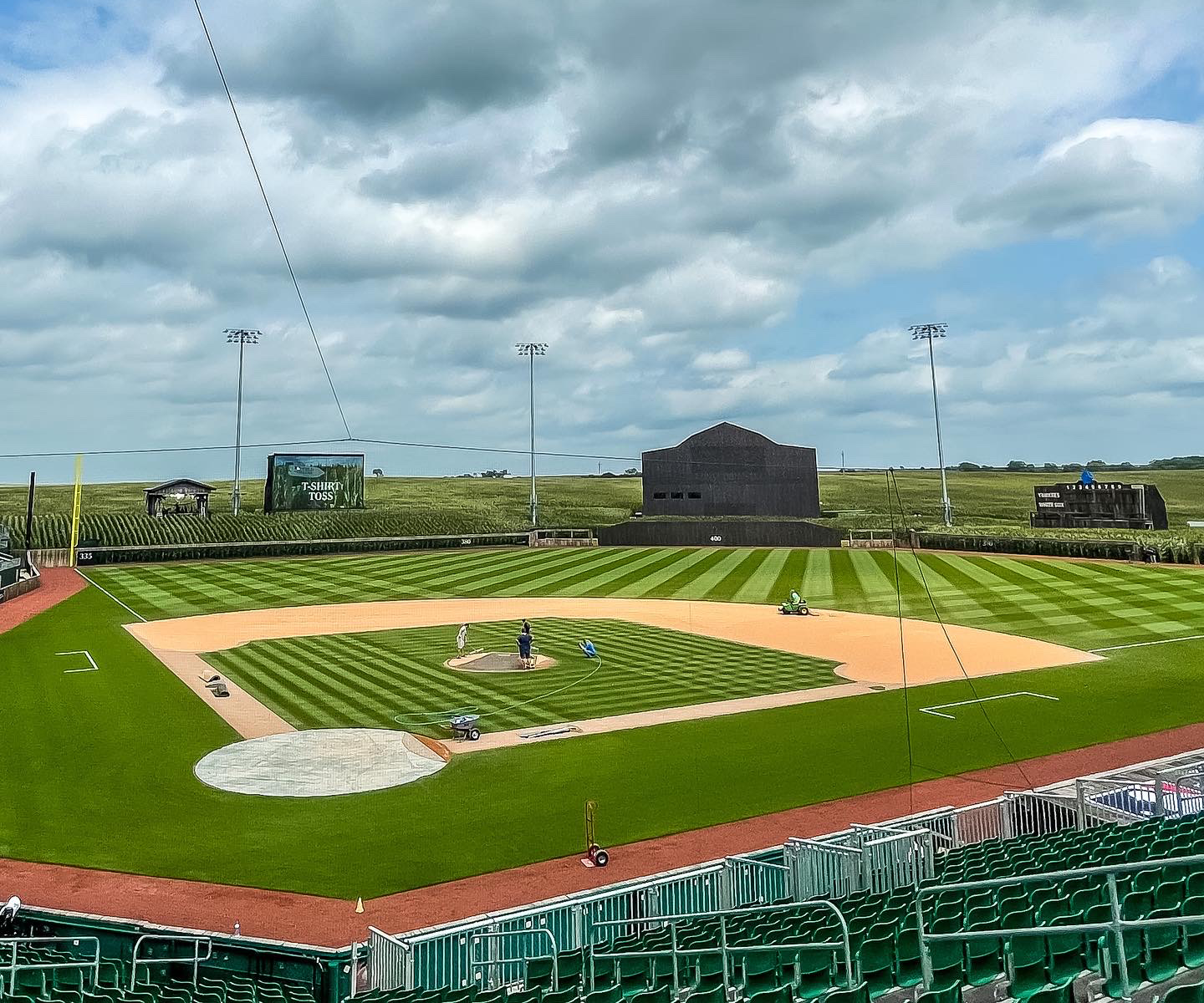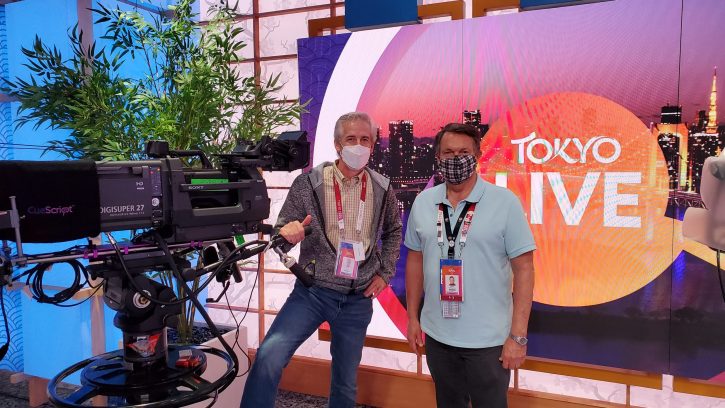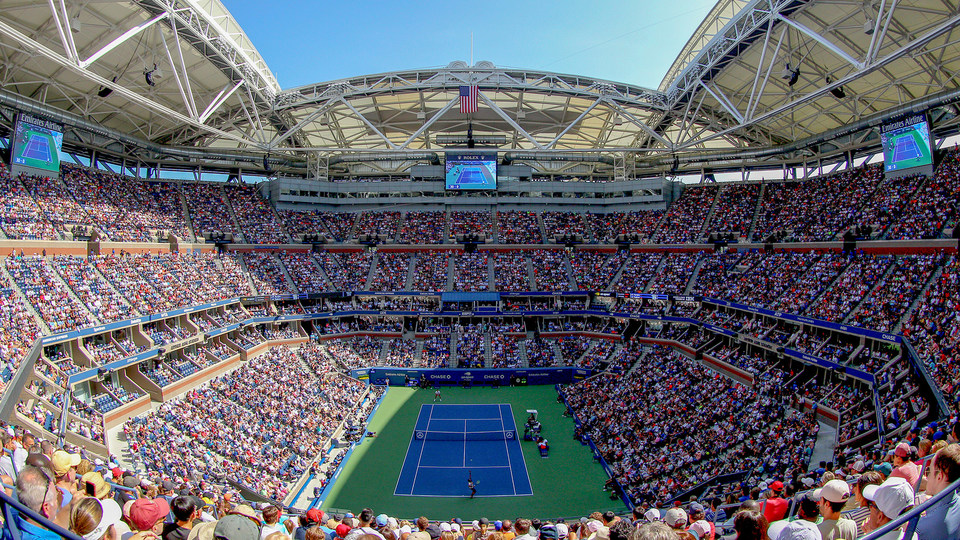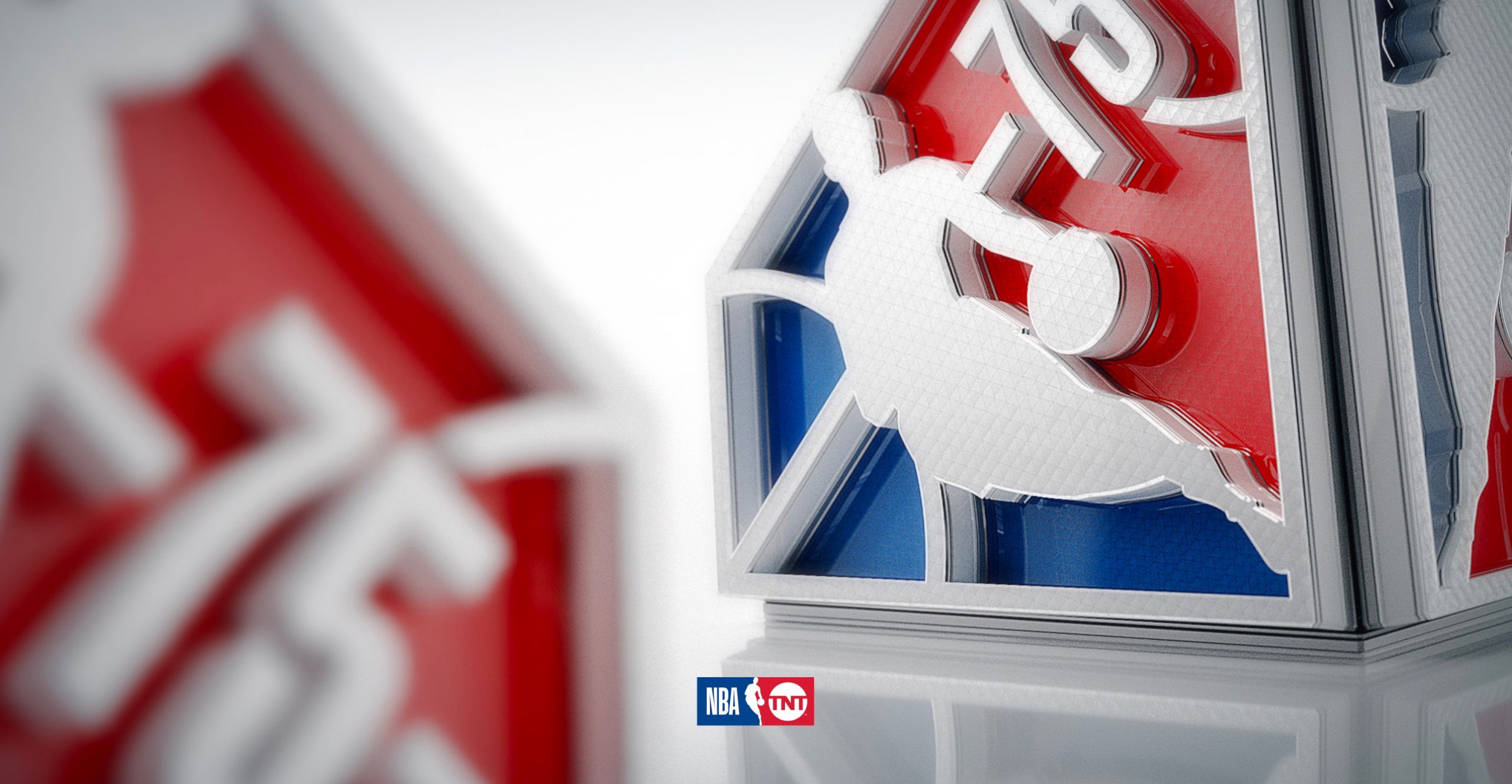2021 in Review (Part 2): A Year Unlike Any Other as Live Sports Productions Navigated a Pandemic-Altered World
Reports from Tokyo Olympics, Field of Dreams, US Open, Ryder Cup, NHL puck-drop, NBA tip-off, and MLS Cup
Story Highlights
After a pandemic-fraught 2020, the live-sports-production industry welcomed 2021 as a return to normalcy. However, new and even greater challenges arose as live sports productions continued to navigate the pandemic throughout 2021. Nonetheless, sports broadcasters, technology vendors, and production-service providers worked together to continue to develop unique new workflows — both onsite and remote — that paved the way for a new era of live-sports broadcasts.
While early 2021 saw near-constant overlap of sports seasons due to schedule changes, the sporting events calendar began to stabilize as the year went on. As a result, sports viewership and ratings began to rise and sports-production teams began to return onsite. Below is part 2 of SVG’s overarching look at how the industry continued to innovate in 2021 (CLICK HERE for Part 1). Check out the monumental efforts undertaken by broadcasters to produce live sports events over the past year despite the ongoing pandemic, including the Tokyo Olympics, MLB Field of Dreams game, US Open, Ryder Cup, NHL puck-drop, NBA tip-off, and MLS Cup.
Tokyo Olympic Games
July 23 – Aug. 8
The Tokyo Games are completed and for many the hard work on the Summer Games is giving way to the hard work preparing for the next Olympics: the Beijing Games to be held next February. Dave Mazza, SVP/CTO, NBC Sports Group and NBC Olympics, did take a moment to reflect on an Olympics experience that, for more than a year, has been unlike any other before.
“We came in with a bit of trepidation because the extra year of planning saw a plethora of new, good ideas from production to enhance the coverage,” said Mazza.“And then we were also trying to make good on some very aggressive technical initia- tives. It made the plan better, but, for every bit of better that it got, it was more daunting as to how we were actually going to pull it off.”
Invariably, an Olympics effort is always compared to previous ones, whether it be ratings comparisons, the scale of the show, or the production achievements. Mazza said the Tokyo efforts were about three times more complicated than the 2016 Rio Games. First, a doubling of the complexity around new technologies and workflows like IP, HDR, 1080p, and immersive audio. Another step up was due to the complications from attempting such a large-scale production during a global pandemic.
From a production element standpoint, Mazza noted things like the Friends & Family effort, which allowed athletes to see and talk to family and friends back home immediately after their event. Born out of the pandemic, it was a complicated effort, often taking a tremendous number of worker-hours to simply get a 10-second shot on-air.
Another extra effort that paid off was apparent during the Opening Ceremony. The show was already expected to have a very different feel from the typical Ceremony, not only because fans were absent but also because the teams and parade of na- tions were being handled in a different way.
From a technology standpoint, the big lift this year was to create a wide variety of video formats floating through the ecosystem in Tokyo, the U.S., and Sky in the UK. OBS provided content in 4K HDR and 1080p SDR, which NBC Olympics then intermixed with its own 1080p HDR as the primary production format. But there was also 1080i SDR, which NBC used for all
the cable and digital feeds to its Stamford, CT, facility. On top of that, NBC Olympics in Tokyo handed off an HDR signal in the HLG standard to the NBC playout facility in Englewood Cliffs, NJ, where it was flipped to PQ and emitted via HEVC compression.
The improvement offered by HDR, 1080p, and immersive audio, he noted, is dramatic and noticeable, especially with proper compression rates and formats.“HEVC compression looks really good at the bitrate we’re using. But we can’t squash it any further, as has happened to HD, because then it won’t look very good. So we’re very pleased with how it looks now.”
The pandemic did more than just make people concerned about health issues. It also caused operations to shift out of Tokyo, most notably production facilities for beach volleyball, basketball, indoor volleyball, diving, and golf.
And it’s not just COVID. The weather resulted in events’ changing times, venues, and more. And all those details needed to be conveyed to multiple teams in multiple places.
Said Mazza, “we could not be doing this [here in Tokyo] without the incredibly hard work of the giant team in Stamford; 30 Rock; CNBC; the NOC; the team in Dry Creek, CO; and Telemundo Center in Miami.” – KK
Field of Dreams
Aug. 12

A total of 40 cameras and 50 microphones covered the field built a quarter of a mile from the original Field of Dreams movie site.
It was a beautiful blend of the past and the future as Fox Sports delivered a special, 4K HDR live production of the MLB at Field of Dreams game between the New York Yankees and the Chicago White Sox from the famous Field of Dreams movie site in Dyersville, IA.
At a new field constructed by Major League Baseball just for this game, Fox Sports deployed a crew of more than 240 people and an arsenal of nearly 40 cameras, 50 microphones, and a commitment to deliver this game in a “cinematic” way that promised to make it quite different from a typical broadcast.
“Yes, it’s a baseball game, but it’s more than that,” said Michael Davies, SVP, field operations, Fox Sports.“We want to make this like a movie. So we’ll use cinematic techniques to tell the story. If there ever was a made-for-TV type of event, this is it.”
Fox brass acknowledged that this was a unique broadcast for them. The broadcaster has a legacy of deploying flashy, futuristic tech for a big project. However, for an event so steeped in legacy, folks like Davies; VP, Field Operations and Engineering Brad Cheney; Director, Field Operations, Francisco Contreras; and Lead Tech Producer Tom Lynch wanted to integrate technology that would deliver a classical feel, rather than a futuristic one.
Among those tools were drones (three supplied by Beverly Hills Aerials), a two-point FlyCam aerial camera system spanning the 1,429 ft. from the movie site to the MLB field, two shallow–depth-of-field Megalodons (each equipped with a mirrorless Sony A1 camera and transmitted to the truck by CP Communications), and a DirtCam buried just off the left- handed–batters box.
Also adding to the classic feel was an entirely new graphics package designed just for this event. Fox Sports EVP/Creative Director Gary Hartley and his team created a package that doesn’t look at all like Fox’s usual MLB scorebug and insert graphics.
Although the game was upconverted from 1080p HDR for delivery to homes in 4K HDR, the majority of the show was captured by cameras shooting in 1080p, 4K, and even 6K (in the case of the drones provided by Beverly Hills Aerials).
Delivering in 4K HDR, Cheney explained, offers a cinematic look to begin with.“With the grass and the colors, you’re able to capture the contrast that 35mm film gives you. HDR gives you that same ability. I think that’s going to translate across, especially to the viewers watching at home on television. You’re going to capture the feeling of a movie with the crispness, the detail, and the contrast.”
To meet the challenge of this production, Fox Sports brought in its top talent, including at the front bench of Game Creek Video’s four-truck Encore unit. The Emmy Award-winning tandem of Producer Pete Macheska, Director Matt Gangl, and Technical Director Paul Harveth was at the front bench. In addition, top A1 Joe Carpenter oversaw the unique audio footprint.
The studio team, headed by Fox Sports VP, Studio Operations, Rod Conti, delivered a design unique to this event. The pre/postgame set was located over the left-field wall amidst the stalks of corn. During the game, however, it would “aesthetically disappear.”
According to Conti, MLB wanted a clear outfield to add to the minimalist mystique of the game. To accomplish that, the studio set was wrapped in a drape that, when dropped, made the set look like an inconspicuous wooden barn. The set was designed with support from Filmwerks, which had a team onsite assisting with the production.
“It’s amazing,” said Cheney,“to see how far we’ve come technologically that we’re in a field in Iowa 40 miles from any city, and we have a gig of high-speed internet to interconnect ourselves to our facility in Los Angeles. The things that people built during the pandemic are applicable here in how we are working. We’ve made extremely large leaps over the past five years.” – BC
US Open
Aug. 30 – Sept. 12
ESPN’s production of both the domestic and the world feed for the US Open continues to evolve, and, this year, it rose to a new level, with court coverage expanding to every court in the Billie Jean King National Tennis Center.
Larry Wilson, associate director, remote production operations, ESPN, zeroed in on the broadcaster’s tennis coverage and saw this year’s Open as an important step after last year’s scaled-down efforts.
“It’s nice to be back and great to see the workforce back,” he said.“This is the largest production we’ve done as the coverage of the main draw and qualifying expanded.”
The biggest change for tennis fans was that the ACES automated court-production systems was expanded to all outer courts. ACES systems comprised a Simply Live ViBox production system and four Fletcher robotic cameras for each court. “We had 14 ACES positions, and, in years past, that has been only five courts for qualifying, so it is a massive expansion,” said Wilson. “Before the main draw even started, we had covered 224 matches on all 14 courts, and we are now extending coverage to all junior and wheelchair matches. Those courts’ coverage used to pack up after Labor Day, but now they are here through the end of the tournament.”
The lack of fans last year gave the ESPN production team and Gravity Media (which oversaw the technical facilities) a huge amount of freedom when it came to new camera locations. For example, last year, Camera 7 was able to be located in the front rows of the stands behind one of the baseline. The return of fans this year meant that that location was not available, but a robotic camera mounted behind the baseline at Arthur Ashe Stadium replaced a camera in the stands.
Camera 9, which was located courtside, was also re- vamped: it was moved to a small Chapman mount tucked into the first row of the stands along the court.
“The cameraman can be in a perfect spot and not be obtrusive to the players,” Wilson pointed out.
Another change from last year was that the 100-ft. tall ESPN SupraCam Tower has been moved to a different location be- cause the previous location is now used for van shuttles.
“It’s on the exact same line, running over the practice courts and through the grounds,” he said. “And SpiderCam is also back in action on Arthur Ashe Stadium.”
The unique challenge this year was not only dealing with evolving COVID-19 protocols but also two massive storms. The first one, Hurricane Henri on Aug. 31, affected the final preparations for the tournament; the second, the remnants of Hurricane Ida on Sept. 1, impacted the tournament itself.
“When Hurricane Henri came in on a Saturday,” said Wilson, “our goal was to be on-air on Tuesday, and we basically had to shut everything down and get any hardware that was out on the ground either to higher ground or into cases and containers. On Saturday, all of our cable was lifted, and the sets were strapped down. Then on Sunday, we came up with a plan so that, when we got here on Monday at 6 a.m., we could start from scratch and basically do a set, shoot, strike to get ready for the qualifiers. But it all worked out.”
As for Ida, the issue there was the amount of water, which Wilson described as mind-blowing.
“The biggest challenge there was the safety of the crew and getting everyone back to their hotels,” he said. “By the time we got on-air the following day, there was only one camera of 172 that still wasn’t working, and that was back up within an hour.” – KK
Ryder Cup
Sept. 24 – 26
For NBC Sports at the Ryder Cup, the skies were clear, production plans came together nicely, and team USA put on a performance that energized golf fans across the country. And for Allison McAllister NBC Sports VP, Golf Operations,
it added up to a great effort across the board with the PGA of America’s partnership and more cooperation than ever between NBC Sports, Sky Sports, and European Tour Productions.
“Things are going well,” said McAllister.“It’s awesome to be here as there’s nothing like a Ryder Cup. The excitement is electric and it’s a very special event and it’s a fun thing to experience.”
McAllister said that with more than 500 people onsite safety was the number one priority, and everyone in the compound and on the course embraced the PGA of America and NBC EHS guidelines.
While the Ryder Cup matches didn’t tee off until the morning of Sept. 24, the Golf Channel was on hand all week, beginning with coverage of the Ryder Cup Captain’s press conference on the afternoon of Monday, Sept. 20. Live prime-time shows also began that evening.“Live From” offered up 50 hours of programming during the week and Marc Caputo, director, remote technical operations, NBC Sports, said innovations included a FlyCam on the first tee that was shared with everyone in the compound. With all the excitement at the first tee, it captured great shots of fans and the unique energy and excitement that defines the Ryder Cup.
“We have 16 total cameras for ‘Live From’ including four Tele- metrics cameras on the set, a Televator Dolly that gives a jib look, that are controlled from a production control room in Stamford,” said Caputo.“We also have three Robovision robotic cameras in the practice areas and because of the team play we have two rover cameras. And then we also have two LiveU units.”
The “Live From” show was cut from PCR8 back in Stamford where there are two EVS playback rooms, two graphics operators, and audio (TopTracer on the range is also controlled from Stamford). An NBC Newbert flypack was on hand for signal transmission to Stamford with 16 transmit and nine return feeds with Lumens providing 10 Gbps of fiber connectivity into the compound.
This was the first Ryder Cup where NBC Sports and Sky Sports were part of the same corporate family. The “Live From” was a hybrid show where Sky produced segments from its studio on the 18th green that air inside the U.S. “Live From” broadcast and vice versa.
“At night when the Sky set is not being used, we move the two ‘Live From’ rovers there and host our inside segments from that studio,” said Caputo.
NBC’s core production efforts were in ND7 while NEP Supershooter 8 and ND5 were on hand in a support role. BSI handled RF systems for NBC, Sky, and the world feed and Fletcher provided robotics. There was plenty of opportunity for resource sharing with NBC Sports, SKY Sports, and European Tour Productions. For example, course coverage was handled by 63 cameras, including three Inertia Xmo super slo-mos. The camera resources were passed into NEP ESU and made available to each of the entities onsite.
In addition to the FlyCam, there was also a camera in a plane, a live drone, and a SteadiCam. Four miles of fiber in the compound and 57 miles across the course kept all facilities connected.
Over the years, TopTracer has become a big part of golf production, making it possible for viewers at home to keep track of ball flight. NBC deployed it heavily for the Ryder Cup.
Hawkeye servers provided an extra level of redundancy to ensure that shots weren’t missed. Two operators worked remotely from Oklahoma while a third operator was onsite at Whistling Straits.
Another technology being used was Whoop. Certain players wore the Whoop wristband that provides heart rate. NBC dropped in a graphic on the first tee that displayed the player’s heart rate in real time as they stepped to the tee which is, arguably, one of the most heart racing tee shots in golf.
“It’s amazing to have those metrics that Tommy Roy and his team are pushing and making that vision a reality,” said Ken Goss, NBC Sports, EVP, Studio and Remote Operations and Production Planning.
Pinpoint wind speed and direction display were also a big part of the show, as were augmented reality graphics – KK
NHL Puck Drop
Oct. 12
ESPN
After a 17-year hiatus, the NHL returned to ESPN this year. During the league’s nearly two decades away, live-production technology has advanced by leaps and bounds, and ESPN is leveraging the latest production tools available to bring NHL on ESPN into the modern age.
ESPN, for the first time, deployed a mirrorless Steadicam on the ice, a SupraCam aerial system, live RF mics on players and in the nets, a drone outside the arena, and a bevy of high-speed, robotic, and POV cameras.
“Our primary goal with the NHL is to bring the game closer to the fan so they see and hear things they’ve never experienced before,” said Chris Calcinari, SVP, remote production operations, ESPN and ABC Sports. “The league has been incredibly open and a great partner in thinking about new technology and new ideas. They are looking to partner with us on trying to bring the fans close to the game, and that has been very exciting.”
In a first for a non-exhibition NHL broadcast, a camera operator is allowed onto the ice during dead-puck situations, coming out of breaks, and for shootouts. A skilled skater operates a Sony Alpha 1 mirrorless camera on a DJI Ronin handheld three-axis camera gimbal to create cinematic-style shallow–depth-of-field shots during celebrations and key moments in the game.
Another new look for NHL coverage is the smooth, sweeping overhead shots from the four-point SupraCam aerial system. The cable-suspended system features a Sony HDC-P1 box cam- era and will run along the nearside glass over fans in the stands.
Steadicam and SupraCam headlined ESPN’s complement of 35 cameras for its season-opening productions in Las Vegas and Tampa. In addition, ESPN rolled out eight ultra-high-speed cameras — six of which were Fletcher robos running at 300 fps (a speed shot, between the benches, one in each net, and one each in the left- and right-side rockers).
Throughout this season, the NHL EDGE puck- and player- tracking system run by SMT is playing a featured role in ESPN’s coverage. Player-pointer graphics will be used live throughout games to highlight movement of players and puck while adding a visual element to analysis. – JD
Turner Sports
It’s a new era for the National Hockey League in the U.S. This season, Turner Sports debuted as a national rightsholder for the league.
Game production will, over the course of the season, lean aggressively into leveraging player- and puck-tracking data provided by the league and displaying unique graphic enhance- ments, including dynamic line changes (where tracking data can be used to monitor shift times and display lineup changes in real time) and a virtual power-play clock projected onto the ice (similar to the virtual shot clock used by NBA on TNT).
“Our goal is to find ways to inform the diehard fan in ways that they haven’t been informed before,” said Turner Sports VP, Sports Production and Technical Operations, Chris Brown, “while also providing information for the casual fan that is try- ing to learn the sport.”
Onsite, the camera complements rely on super-slow-motion cameras, with more deployed than for a typical show. Of the 25 camera feeds (20 are originated by Turner; five are blue-line cams and net-cam feeds provided by the league), from eight to 11 units on a given night will be high-frame-rate cameras.
Coordinating directly with the league on venues and standard game-broadcast operations has proved critical to helping Turner boot up this property in a relatively short time. To help out on the remote technical side, Turner added Eric Grossman, a veteran of hockey broadcasting, as lead tech manager.
“One of the biggest things with the NHL is developing all of the new workflows that are going to have to surround it,” said Brown.“[That’s] not just in the remote environ- ment but in the studio as well because of the conflu- ence of highlight operations. There’s tons we have been trudging through to pull this all together. We’re also doing this while maintain- ing the technical quality for all the productions that we do and giving each property its just attention.” – BC
NBA Tip-Off
Oct. 19
Turner Sports
After centralizing the bulk of its productions at its Tech- wood Campus in Atlanta and remoting from a truck to the facility for nearly 60 NBA games last season, Turner Sports hit the road again for NBA broadcasts. Deploying NEP TS2 and Supershooter 8 mobile units, Turner plans to deploy nearly all announcers and crew onsite at the arena.
“Last year, COVID accelerated a lot of concepts that we were already thinking about,” said Chris Brown, director, technical operations, Turner Sports.“However, because of COVID, we had the unique opportunity to have a lot of space that I don’t anticipate will be available as we push into the new year and start returning to the office. While we’re excited about the technology — and I think there’s going to be a time and a place for us to eventually move to that as one of many different production options — we’re just not quite there yet in terms of core infrastructure and space [in Atlanta].
“What we were able to do last year was prove a concept,” he continued.“I think that was significant because, if and when we have the available infrastructure at the facility in Atlanta to manage things like this on a full-time basis, we now know we can do that.”
Turner Sports’ current use of REMI production workflow will be limited to the virtual–shot-clock operator, who will be located in Atlanta. All other crew, however, will be onsite in the truck.
Turner rolled out a brand-new graphics package for wrap- arounds, debuting its revised NBA on TNT look. The package was built on a diamond motif, matching the league’s special diamond-shaped logo for its 75th season. In addition, viewers see refracted light on many graphics elements as if they were looking through a diamond.
“We’re coming from a package that was very mono- chromatic and dark with everything desaturated to a very vibrant, colorful, juicy package,” said Jordan Shorthouse, VP, creative director, Turner Sports. “I think it’s phenomenal, and it’s going to play perfectly into this year’s telecasts. We loved the [previous package], but we’ve been living with that dark package for four or five years and were definitely ready for a change. We just wanted something with more vibrancy, more color, more fun, and that’s what you’re going to see when this package hits air.” – JD
ESPN
ESPN’s NBA team is making significant strides toward a return to onsite productions, but, throughout the 2021-22 calendar, remote workflows will still handle the bulk of each broadcast’s on-air elements. Regular REMI-powered workflows, like EVS replay and Clock and Score, and REMCO (remote-controlled) workflows, like Vizrt graphics, will be housed at production facilities in Bristol, CT, and Charlotte, NC. REMCO is the broad- caster’s remote-graphics solution formerly branded as GREMI.
“Our REMI-based executions will feature producer and director teams to integrate production assets,” said Mike Foss, senior director, remote production operations, ESPN.“REMI executions will allow us to produce our NBA content with fewer production personnel and fewer technical assets located onsite.”
Along with offsite resources, ESPN is using its normal camera complement and extend use of the shallow-depth-of-field camera.
Aside from onsite and offsite technologies, NBA games on ESPN’s networks will include numerous production highlights. With history being made in Major League Baseball (at both ESPN and AT&T SportsNet Rocky Mountain), motorsports, golf, and other sports, professional men’s basketball on ESPN will be covered by an all-female on-air and production team at a to-be-determined date this season.
In addition, the broadcaster will once again dive into alternative broadcasts after the success of its Daily Wager Special between the Philadelphia 76ers and Brooklyn Nets on April 14 and Marvel’s Arena of Heroes between Golden State Warriors and New Orleans Pelicans on May 3. All these new initiatives are testament to the hardworking staffers who work not only on these NBA games every night but on all basketball productions at ESPN.
“We’re incredibly lucky to work with so many talented, committed, and accommodating professionals,” said Tim Corrigan, senior coordinating producer, ESPN.“Everyone has been willing to make personal and professional sacrifices, and our team understands the responsibility that comes with covering the NBA, Summer League, G League, FIBA, and the WNBA.”–KH
MLS Cup
Dec. 11

Pole Cam captured this save by Philadelphia Union goaltender Matt Freese in the Eastern Conference Finals.
The 2021 MLS season came to a fitting close on Dec. 11 with the MLS Cup Final on ABC between the Portland Timbers and New York City Football Club. In a venue with one of the league’s most electric atmospheres, Portland, OR’s Providence Park, the title match will live up to its billing with technological ingenuity that includes a pair of Pico Pole Cams, a quartet of Goal Cams, and a full onsite production.
“The scene will be amazing,” said Amy Rosenfeld, VP, production, ESPN. “We couldn’t have asked for a better environment. We found out about the final’s location only a week ago, but, despite the busy time of year, this production will be in very good hands.”
ESPN covered every nook and cranny of the playing pitch with a total complement of 28 cameras, including an aerial perspective through Skycam, a Pico Pole Cam situated behind the net, and a Goal Cam embedded within each goalpost.
“I think [the Pico Pole Cam] is an innovation that has been additive to our editorial coverage,” says Rosenfeld. “We want to own that space around the net, and I think we’re doing that reasonably well.”
The camera feeds were shared with a side-by-side presentation of the match on Univision’s TUDN. The Spanish-language network supplemented its coverage with three dedicated cameras, giving ESPN three additional angles for replay purposes.
With the effective vaccines and steadfast implementation of health and safety regulations, ESPN created a compound that allowed all personnel to return onsite. NEP’s Supershooter 8 and ST mobile units handled the day’s programming. A lot changed since the last time ESPN aired the MLS Cup Final in 2019, including new technology and production philosophies.
“When we produced the playoffs in 2019,” Rosenfeld explains, “we had double-headers where one game on ABC was done in [an onsite] truck and the other game was a REMI. It’s interesting because the bulk of the team has been doing REMIs, so what’s old is new again since we’re back in a truck.”
Along with the behind-the-scenes staff, on-air talent was also be onsite to preview the match and call it live. The studio set was located in the far-right corner of the concourse for two reasons: the background is an impressive view of the pitch and provides cover from the expected inclement weather.
Mark Clattenburg also debuted as MLS Cup rules analyst, giving the match is getting a boost of officiating expertise. For his first match, the crew gave him all the camera angles necessary to give his best opinion on a play.
“He’ll have multiple monitors and a quad feed of several camera outputs in addition to naturally watching the game live,” said Matt Leach, coordinating producer, ESPN. “He’ll also have the output of the video-review monitor that they’re looking at in the review room.” – KH





